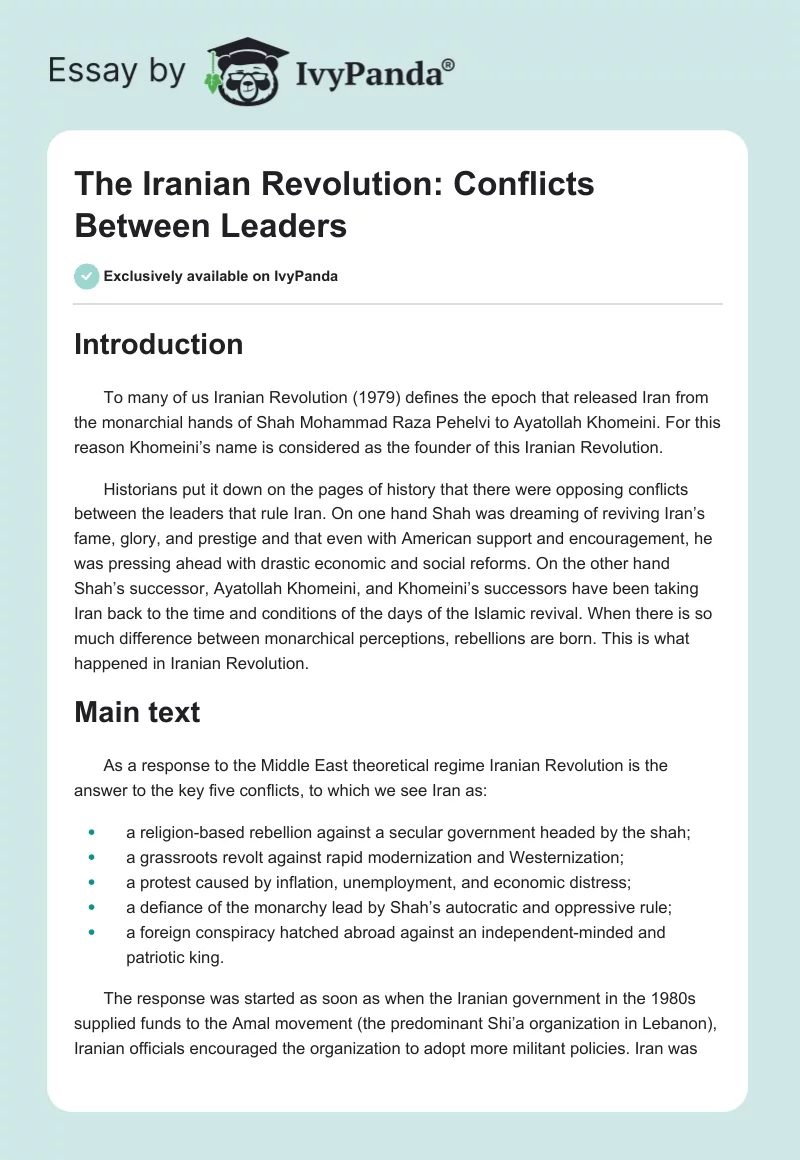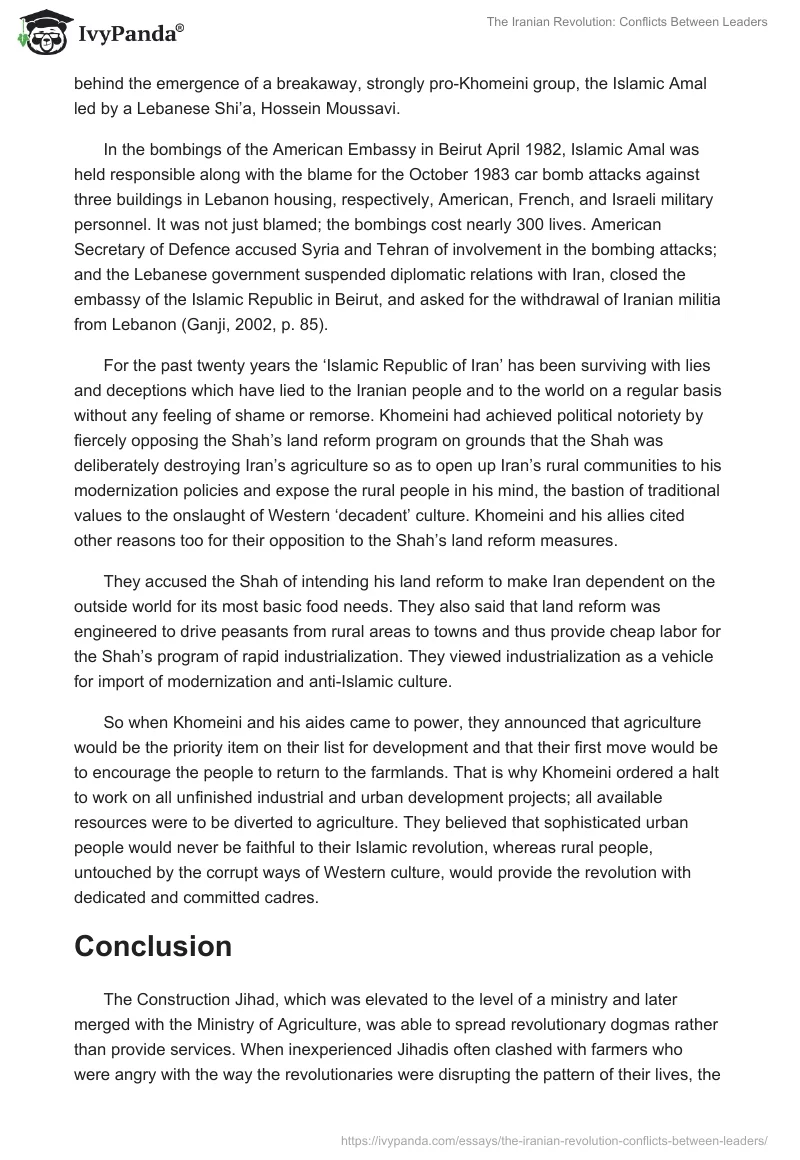Introduction
To many of us Iranian Revolution (1979) defines the epoch that released Iran from the monarchial hands of Shah Mohammad Raza Pehelvi to Ayatollah Khomeini. For this reason Khomeini’s name is considered as the founder of this Iranian Revolution.
Historians put it down on the pages of history that there were opposing conflicts between the leaders that rule Iran. On one hand Shah was dreaming of reviving Iran’s fame, glory, and prestige and that even with American support and encouragement, he was pressing ahead with drastic economic and social reforms. On the other hand Shah’s successor, Ayatollah Khomeini, and Khomeini’s successors have been taking Iran back to the time and conditions of the days of the Islamic revival. When there is so much difference between monarchical perceptions, rebellions are born. This is what happened in Iranian Revolution.
Main text
As a response to the Middle East theoretical regime Iranian Revolution is the answer to the key five conflicts, to which we see Iran as:
- a religion-based rebellion against a secular government headed by the shah;
- a grassroots revolt against rapid modernization and Westernization;
- a protest caused by inflation, unemployment, and economic distress;
- a defiance of the monarchy lead by Shah’s autocratic and oppressive rule;
- a foreign conspiracy hatched abroad against an independent-minded and patriotic king.
The response was started as soon as when the Iranian government in the 1980s supplied funds to the Amal movement (the predominant Shi’a organization in Lebanon), Iranian officials encouraged the organization to adopt more militant policies. Iran was behind the emergence of a breakaway, strongly pro-Khomeini group, the Islamic Amal led by a Lebanese Shi’a, Hossein Moussavi.
In the bombings of the American Embassy in Beirut April 1982, Islamic Amal was held responsible along with the blame for the October 1983 car bomb attacks against three buildings in Lebanon housing, respectively, American, French, and Israeli military personnel. It was not just blamed; the bombings cost nearly 300 lives. American Secretary of Defence accused Syria and Tehran of involvement in the bombing attacks; and the Lebanese government suspended diplomatic relations with Iran, closed the embassy of the Islamic Republic in Beirut, and asked for the withdrawal of Iranian militia from Lebanon (Ganji, 2002, p. 85).
For the past twenty years the ‘Islamic Republic of Iran’ has been surviving with lies and deceptions which have lied to the Iranian people and to the world on a regular basis without any feeling of shame or remorse. Khomeini had achieved political notoriety by fiercely opposing the Shah’s land reform program on grounds that the Shah was deliberately destroying Iran’s agriculture so as to open up Iran’s rural communities to his modernization policies and expose the rural people in his mind, the bastion of traditional values to the onslaught of Western ‘decadent’ culture. Khomeini and his allies cited other reasons too for their opposition to the Shah’s land reform measures.
They accused the Shah of intending his land reform to make Iran dependent on the outside world for its most basic food needs. They also said that land reform was engineered to drive peasants from rural areas to towns and thus provide cheap labor for the Shah’s program of rapid industrialization. They viewed industrialization as a vehicle for import of modernization and anti-Islamic culture.
So when Khomeini and his aides came to power, they announced that agriculture would be the priority item on their list for development and that their first move would be to encourage the people to return to the farmlands. That is why Khomeini ordered a halt to work on all unfinished industrial and urban development projects; all available resources were to be diverted to agriculture. They believed that sophisticated urban people would never be faithful to their Islamic revolution, whereas rural people, untouched by the corrupt ways of Western culture, would provide the revolution with dedicated and committed cadres.
Conclusion
The Construction Jihad, which was elevated to the level of a ministry and later merged with the Ministry of Agriculture, was able to spread revolutionary dogmas rather than provide services. When inexperienced Jihadis often clashed with farmers who were angry with the way the revolutionaries were disrupting the pattern of their lives, the areas where cash crops were cultivated, the farmers resented interference by the revolutionaries who insisted that on the orders of the regime, all available land must be given to wheat farming. Meanwhile, local mullahs and former landlords were agitating in an effort to grab farmland and agricultural estates, which had been taken over by the Construction Jihad’s activists.
Work Cited
Ganji Manouchehr, (2002) Defying the Iranian Revolution: From a Minister to the Shah to a Leader of Resistance: Praeger: Westport, CT.


